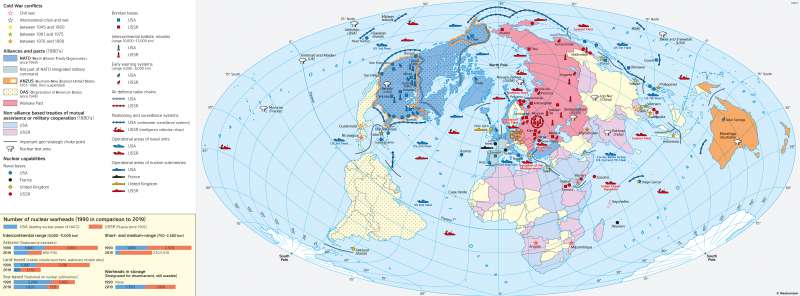The World - The Cold War Era (1949–1989)
Alliances since World War Two
978-3-14-100890-6 | Page 32 | Ill. 3

Overview
The Cold War (ca. 1949-1989) developed from the political antagonism of the victorious powers of the Second World War and the ideologically shaped East-West conflict between the great powers, the US, and the Soviet Union. Although the conflict, which lasted more than 40 years, never escalated into a real war, it dominated political developments in the second half of the 20th century worldwide. To this day, the international alliance system is shaped by its "aftermath"
The beginnings of polarisation
The members of the Allied war coalition began to secure their spheres of interest during the major war conferences (Tehran 1943, Yalta, and Potsdam 1945). The Soviet Union wanted to create a political and economic zone of influence in Eastern Europe. The USA, on the other hand, was interested in reducing military expenditure in favour of a new international beginning ("One World Concept"). The founding of the United Nations in 1945 also served this purpose
The USA initially accepted the Soviet approach in Eastern Europe (Poland 1945/46). However, the government under Harry S. Truman (1945-1953) soon saw this as an attempt to achieve communist world domination by supporting Soviet-oriented people's democracies. The doctrine of containment of the Soviet Union ("Containment") officially proclaimed by Truman in 1947 through economic and military support of Western democracies, e.g. in the form of the Marshall Plan (1947) or the North Atlantic Treaty Organisation, NATO (1949), visibly worsened bilateral relations. The first political crises were concentrated in Europe, but with worldwide support for anti-communist regimes, the "containment" policy soon influenced happenings globally. The USA took on the role of a (Western) world order power.
The Soviet Union initially lacked the military capacities to compete with the USA. Through a "Treaty of Friendship" (1950) with China, which had been communist since 1949, Stalin tried to create a "communist bloc" from Eastern Europe to the Pacific under Moscow's leadership. However, relations between the two countries remained tense; Beijing went its own way ideologically and in foreign policy.
Military alliances
After the political division of Europe, a series of international crises (Korean War 1950-1953, Taiwan crisis 1950-1954, Cuban Missile Crisis 1962) and the establishment of global alliances and pacts (e.g. OAS 1947/48, NATO 1949, Warsaw Pact 1955), the intensification and militarisation of the East-West conflict was unstoppable. Depending on foreign policy concepts and military strategies, its intensity fluctuated between "hot phases" (1947-1961), "détente" (1963-1975), "high armament" (1979-1985) and increasing "dialogue" (from 1986), which led to the political upheaval in Eastern Europe and ended the Cold War. This upheaval was favoured by increasing economic and supply difficulties within the socialist world of states allied with the Soviet Union, as well as by environmental disasters such as the nuclear accident at the Chernobyl nuclear power plant in 1986.
In the course of the East-West conflict, both superpowers built up a globally operating military power by positioning naval and air bases in allied states. They threatened the territory of the adversary with intercontinental nuclear missiles. The attempt to be able to react to possible attacks through early detection steered the armed forces towards defence systems (radar early warning systems). They were space-based from the mid-1980s, and the network was completed by reconnaissance satellites. The number of American and Russian nuclear warheads decreased from 1990 to 2015, but both sides still own many warheads of different kinds (see box on the left).
Structural features of the Cold War
The Cold War era was characterised by a strong ideological penetration of foreign and security policies. Additionally, the worldwide support of friendly regimes contrasted military interventions by their own armed forces or allies (e.g. Vietnam 1965-1973 or Afghanistan 1979-1985).
However, the existing nuclear weapons prevented a direct confrontation. From the 1960s onwards, both world powers had become superpowers because of their intercontinental nuclear weapons. They dominated their respective sides and tried to keep their allies under control but avoided a direct confrontation with the political counterpower. When the USSR moved medium-range missiles to Cuba in October 1962, which had become an ally of the Soviet Union a few years earlier through a communist people's revolution, the world was on the brink of a nuclear clash for a few days, but this was avoided by the Soviet giving in. The gigantic weapons and military arsenal of both sides, which had the potential for the extensive destruction of humanity and its civilisation, functioned as a inhibition threshold for a direct military confrontation - although it could never be completely ruled out.
The arms race between the nuclear powers USA and USSR paralyzed the international system. It prevented the emergence of a third, independent force in world politics, for example on the part of the decolonised developing countries, but it also neutralised the United Nations - founded with idealistic intentions - in its ability to act in world politics.




